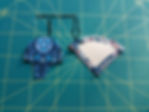Tips for glue basting and sewing curves in epp
- Irina
- Apr 25, 2020
- 3 min read
You are ready to explore curved shapes (clamshells, apple cores etc.) in English paper piecing but not sure how to tackle them? Then this post is for you! Curved hand piecing might be tricky as it is not easy to match the points but I hope these tips will help you to concur the curves.

1. Use pre-cut templates
I cannot stress enough using pre-cut templates for curves. First, they are cut precisely. Second, they are thicker than regular paper and help you achieve smooth curves. Third, they can be used several times. Fourth, trust me you don´t want to cut curved shapes with scissors. When I was working on my clamshall pillow I cut first 100 templates with scissors. I would never do that again.

2. Glue basting
It is a quick method that allows you achieve great results and accuracy. I am sure once you try, you will never go back to thread basting (at least with the curves).
When I started epp I didn´t know what type of glue to use. So I bought regular fabric glue stick. Lessons learnt, never again. It was difficult to apply small amount of glue, I had sticky hands and it was very hard to remove the papers at the end.
I highly recommend using Sewline glue pen. It is designed for epp, so you will never have the problems I mentioned above.
Before cutting the fabric apply a dab of glue to the middle of your paper piece and stick the shape to the wrong side of the fabric. Cut the shape with seam allowance (either 1/4 or 3/8 inch, depending on the size of your papers) using your preferred method. I like cutting with scissors while others prefer rotary cutters. Then apply SMALL amount of glue along the paper shape but not too close to the edge and fold the seam allowance. Start with the shortest side or straight edges if you shape has a curve.
Convex curves
Upper curve of a clamshell is convex.
In Brimfield Star block the curved shape has both straight edges and convex curve, so you glue baste first the straight sides and then the curve.

Apply small amount of glue not too close to the curved edge and starting from one side baste the shape, slightly turning the piece as you go. If you feel that the curve is not smooth, simply pull the fabric from the paper piece, add some glue and baste again.
Here is a short video how to glue baste a convex curve on clamshell.
Concave curves
Examples of a concave curve - bottom curves of a clamshell or the Brimfield star block.

Once you glued the shape to the fabric and cut the piece with seam allowance, make small cuts in the seam allowance along the curve (for example if your seam allowance is 1/4 inch then these cuts should be 1/8 inch). These cuts allow you to baste the shape neatly. First baste straight edges by applying the glue along the edge and folding seam allowances. Now do the same along the curve.
Here is a video how to glue baste concave curves.
3. Sewing the curves
I think it is a matter of personal preference. You can use either a flat back stitch or whip stitch.
Here is a video how to do flat back stitch by @karenthediyaddict.
I usually whip stitch my curves. First, I fold basted shapes in half to determine the centers and match the centers on both pieces. Then I stitch one side from the center towards the edge. It feels easier to hold the shapes in a way that I stitch away from me but not towards myself. It is easy to whip stitch in the center, once you move towards the edge it is gets more difficult. My trick is to hold both shapes that they form 90 degrees angle.
4. Removing the paper pieces
It is not difficult to remove the paper pieces if you glue basted them with Sewline glue. Simply lift the fabric from the paper. You can either lift the fabric all the way around the paper piece and take the paper out, Or you can lift the fabric just on couple of sides, take the paper shape by the corner, wiggle it a little and gently remove paper piece.
Here is a video how to remove paper from the Brimfiled star block.
If you applied too much glue, the papers might be stuck to the fabric. In this case, simply spray some water at the back side of your work, wait for a minute or two and then you can easily remove the papers.
Happy Stitching!


